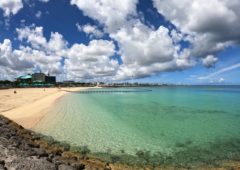2017.02.15
Annual dance of humpbacks off Zamami is in full swing
Every winter from end of December through early April, humpback whales make their annual migration to waters off Okinawa, and whale watching has become one of the main tourist attractions here.
It’s easy for people to watch the lumbering mammals off the Kerama Islands, and tours are the simplest way to join Mother Nature as her ocean giants make a show.
Zamami Island has become the center of the whale watching industry in Okinawa, and the Zamami Whale Watching Society is responsible for alerting the tour organizers for the arrival of the whales and also organizes dozens of tours through March, the peak whale watching season. The entire season is being billed the Zamami Village Whale Watching Festival.
English language information on Zamami Island, tours and accommodations are all available at their website at https://zamamitouristinfo.wordpress.com/
There is a choice of watching for whales up close from a moving boat, or from an observation platform with binoculars at the Whale Conservatory in Unazati on Zamami Island. For those prone to become seasick, the observation platform is recommended. Whale Watching Society members use the Conservatory to spot the whales, and relay their location to the boats.
Another ashore site on Tokashiki Island is the Okinawa National Youth Center atop Mt. Akama. The Center offers not only the view, but inexpensive accommodations and more.
The Kerama Islands are located 25 miles west of Naha. The area was once a popular whaling ground. Today, the area is restored as a main whale breeding ground. There are now 35,000~45,000 humpbacks in the world.
Humpback whales are part of a family of species including the blue whale, fin, minke, sei and Bryde’s whales. Black, with a mottled black and white underbelly, the humpbacks grow to lengths up to 52’ (16 meters). They feed on fish and krill, a shrimp-like crustacean, eating 1~1½ tons of food a day.
The whales are active and energetic, and enjoy splashing and doing flips in the water. They have dorsal fins on their backs and ventral plaits running from the tip of the lower jaw back to the belly. Scientists explain that each whale is unique, the color and shape of those fins and plaits, as well as the details of the tail fin, are as individual as fingerprints from whale to whale. No two are alike.
Humpback whales sexually mature in the six-10 year age range. Females calve once every 2-3 years, with gestation taking 12 months. One of their birthing grounds is off the Kerama Islands, which brings back the reasons for the whale watching tours.



 2024.04.10
2024.04.10 2024.01.31
2024.01.31 2024.01.02
2024.01.02 2023.12.27
2023.12.27 2023.11.16
2023.11.16 2023.11.14
2023.11.14 2023.11.10
2023.11.10 2023.10.26
2023.10.26 2023.10.16
2023.10.16 2023.09.14
2023.09.14






